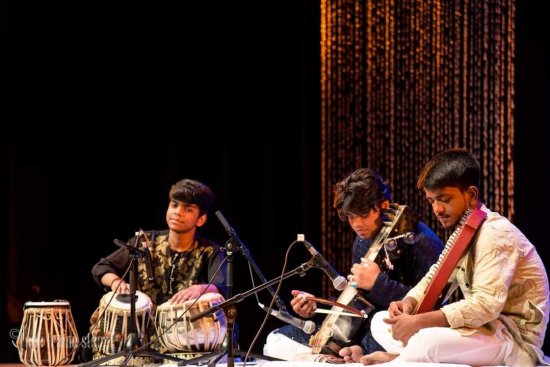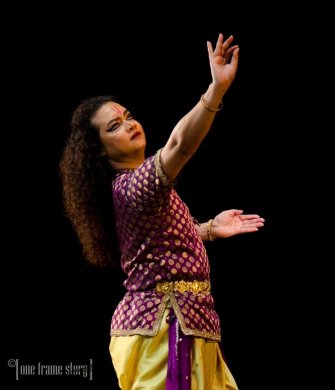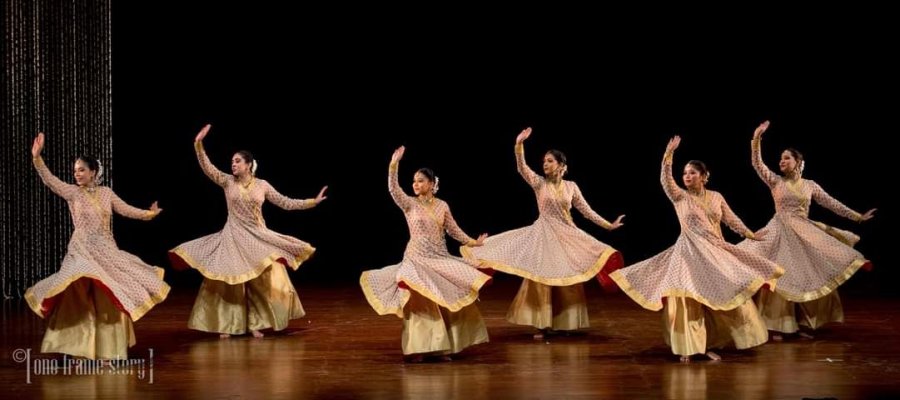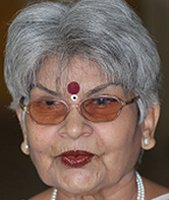
|   |

|   |
8th Natnagar Festival of Abhyas - Manjari Sinha e-mail: manjari@sinha.com Photos: One Frame Story August 9, 2023 'Abhyas', an association of art, culture, and social welfare established in 2008 by Guru Kishan Mohan Mishra, presented their 8th Natnagar Festival of Music and Dance celebrating the 84th birthday of Late Pt. Birju Maharaj at the Kamani auditorium in Delhi. The festival showcased Kathak in solo, duet, and group performances opening with music featuring Mohd Tabish on sarangi and Mohd. Ariz on tabla, the gifted sons of the sarangi maestro Ghulam Mohd.  Mohd. Ariz, Mohd Tabish, surmandal accompanist Sarangi and tabla have been integral parts of Kathak's musical ensemble. If the tabla reciprocates the bol, mnemonics of Kathak, the sarangi helps maintain the time with its musical refrain adding melody to the time-cycle of the taal being danced. Guru Kishan Mohan believes in promoting and nurturing young talents in this important area hence he invited the young duo Mohd Tabish and Mohd Ariz, to open the festival with their delightful jugalbandi (duet) of sarangi and tabla. Coming from the musical lineage of Moradabad gharana, Tabish is the maternal grandson (Nati) of Ud. Siddique Khan and the paternal grandson (Pota) of Ud. Ghulam Sabir Khan, whereas Ariz is the disciple of Manju Khan and Aman Ali Khan of Ajarada gharana. Genetics and grooming from early childhood have played major roles, which was evident right from the selection of the challenging yet timely raga Marwa. The gradual badhat of the raga and the gamak taans during Bada Khayal set to vilambit (slow) ektaal and complicated taiyaar taans in drut teental bandish along with the steadiness of perfectly tuneful swaras and the deft handling of the bow spoke of Tabish's proper training and diligent riyaaz. Ariz used the broad-faced tabla for accompanying the vilambit and the small-faced tabla for the drut bandish. His dagge (left-hand drum) ka kaam for the gamak taans and scintillating laggi for the concluding segment of 'Dadra' (wrongly announced as Thumri by Tabish), vouched not just for his training and practice but also for his intelligent 'Sangat' accompaniment. One wished them both to keep up the sadhana with the same dedication.  Vishal Krishna The solo performance by Vishal Krishna, a young representative of Benaras gharana brought a different flavour for dance lovers of the capital who are treated more often to Lucknow or Jaipur gharana Kathak. Opening with the Shivastuti "Nagendra haraya trilochanaya..." in the serene swara of raga Bairagi, he chose teentala for his nritta segment. Citing his father who used to say "Just like the vocal and instrumental music, dance should also start with Alapchari" he opened with Chalan and Aamad, proceeding towards a refreshingly different version of "Dhatak Thunga" that was prefixed with 'Tdha!' all through. He showcased the typical andaz of Gopi Krishna in "Tat tat ta drig Nandan", preceded with a 'Dopalli Paran', then Sitara Devi's signature style "Kit tak thun thun..." before showing the difference between the Gat-Nikas of Benaras and Lucknow gharana presenting "Krishna ki Gat", concluding his performance with dancing on the edge of a brass plate demonstrating intricate rhythmic patterns. The impromptu tabla reciprocation by Abhishek Mishra, trained in Benarasi Baaj (Benaras style of playing tabla), was remarkable.  Vidha Lal & Gauri Diwakar The duet by Gauri Diwakar, a talented dancer from Lucknow gharana trained under Pt. Birju Maharaj, Jai Kishan Maharaj and Aditi Mangaldas, and Vidha Lal, the ace disciple of Guru Geetanjali Lal of Jaipur gharana, was a unique presentation. Based on 'Ekaakar', a beautiful poem written by Pt. Birju Maharaj describing the oneness of the alluring 'Yugal-Murti' of Radha-Krishna: "Ith Radha bank-bhrikuti jaiso kamaan laagyo, Vaate Krishna bhaal tilak preeti baan lagyo hai. Milat hi paraspar ut kaam baan chhoot gayo, Ang-ang, adhar-adhar, nain-bain laagyo hai. Jodi adbhut lakhi lakhi mohit bhaye Kaamdeva, Chhodi chhadi pushp baan charnan jhuki lagyo hai. Nirtat 'Brijshyam' yog bhakti gyaan roop paaye, Dhandhan kahi bhaag more, Kaanha dhun laagyo hai!" They both sensitively portrayed the emotive content of the divine love, showcasing the nuances and stylistic differences of both the Kathak gharanas taking turns alternately with their solo nritta sequences, interspersed after each couplet of the poem. The title of the poem was literally translated in the concluding pose when both of them entwined together becoming one. The music enhanced the dance with Yogesh Gangani on tabla, Mahaveer Gangani on pakhawaj, Mudassir Khan on sarangi and Samiullah Khan on vocal support with appropriate ragas and taal patterns like Charukeshi for "Ang-ang, adhar-adhar, nain-bain laagyo hai" or "Dig dig thei ta thei ta thei" or Kavitta, Gat-Nikas and the Jhoola-Paran and the concluding Tatkaar by both the dancers climaxing with becoming one 'Ekaakar'!  Abhyas repertory The group presentation by the well-trained dancers of Abhyas repertory literally translated the verse "Karat karat Abhyaas ke / Jadamati hoth Sujaan", or 'Practice makes a man perfect'! Trained under the watchful eyes of the hard taskmaster Guru Kishan Mohan Maharaj, each one of the dancers showed graceful movements and perfect synchronization. Abhyas group presented two items 'Shahi Mehfil' and 'Ullas' in-between the solo and duet performances. Shahi Mehfil opened with the oft-heard Rubai "Kabhi ban sanvar ke jo aa gaye / Toh bahar-e-husn dikha gaye..." composed in the romantic fervour of raga Pilu that continued for the Nagma or Lehera also for the following nritta sequence with Aamad, Thaat, Tode-Tukde, Paran et al, set to medium and fast tempos of teentala. Then there was Jhaptala where the musical refrain was in raga Malkauns covering both madhya and taal Saptak alternately. The concluding segment again bringing in the romance of Pilu had Gat-Nikas and Ladi of 'takit takit dhin' with its 'Ulat-Palat' (permutations and combinations) concluding with the exit of all the dancers executing the typical 'Salami' to match the ethos of the 'Shahi Mehfil'! 'Ullas' was the second group choreography by Abhyas repertory. Based on Amir Khusro's composition "Eri Sakhi more piya ghar aaye...", it served the purpose of their abhinaya segment.  Manjari Sinha has an M.A. in Sanskrit and Music, and trained in vocal, tabla, sitar and Kathak dance. She has regular columns in national dailies as a music and dance critic. |